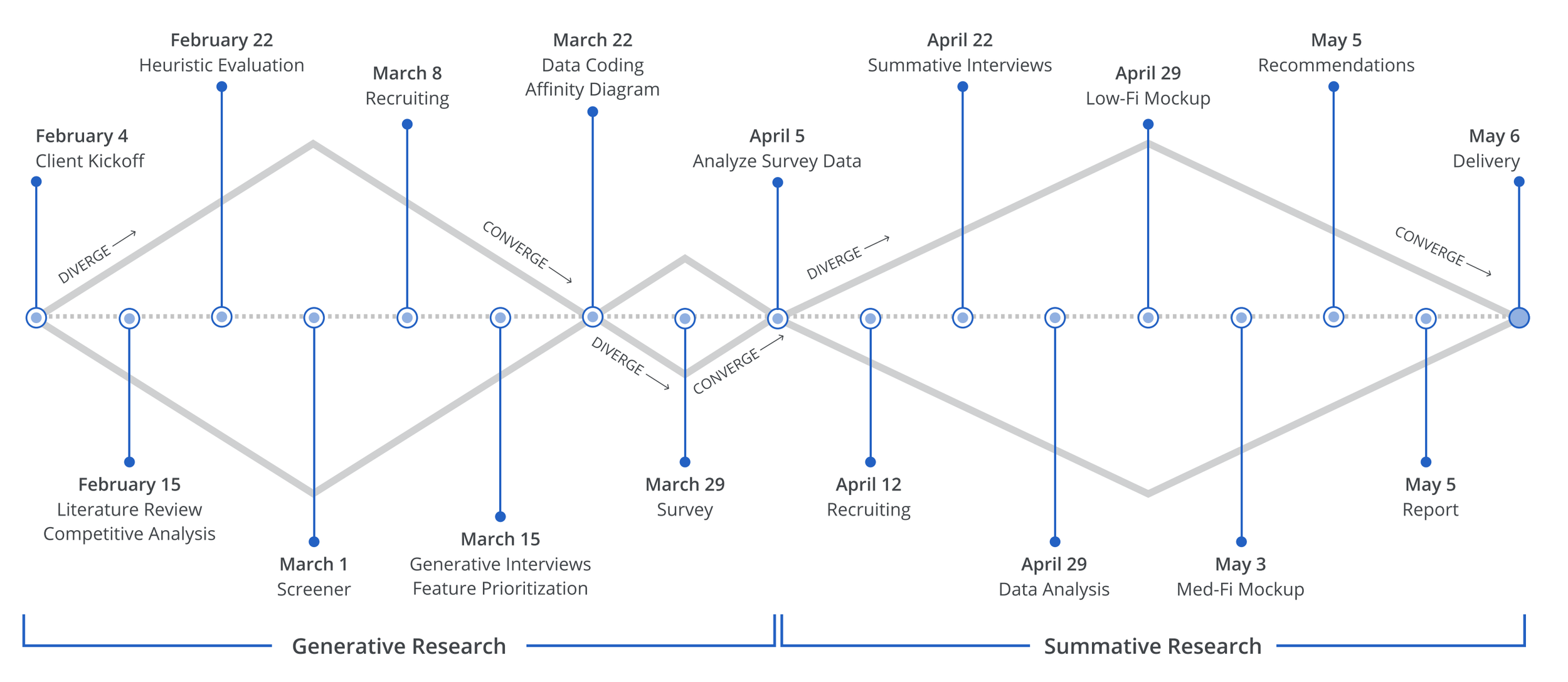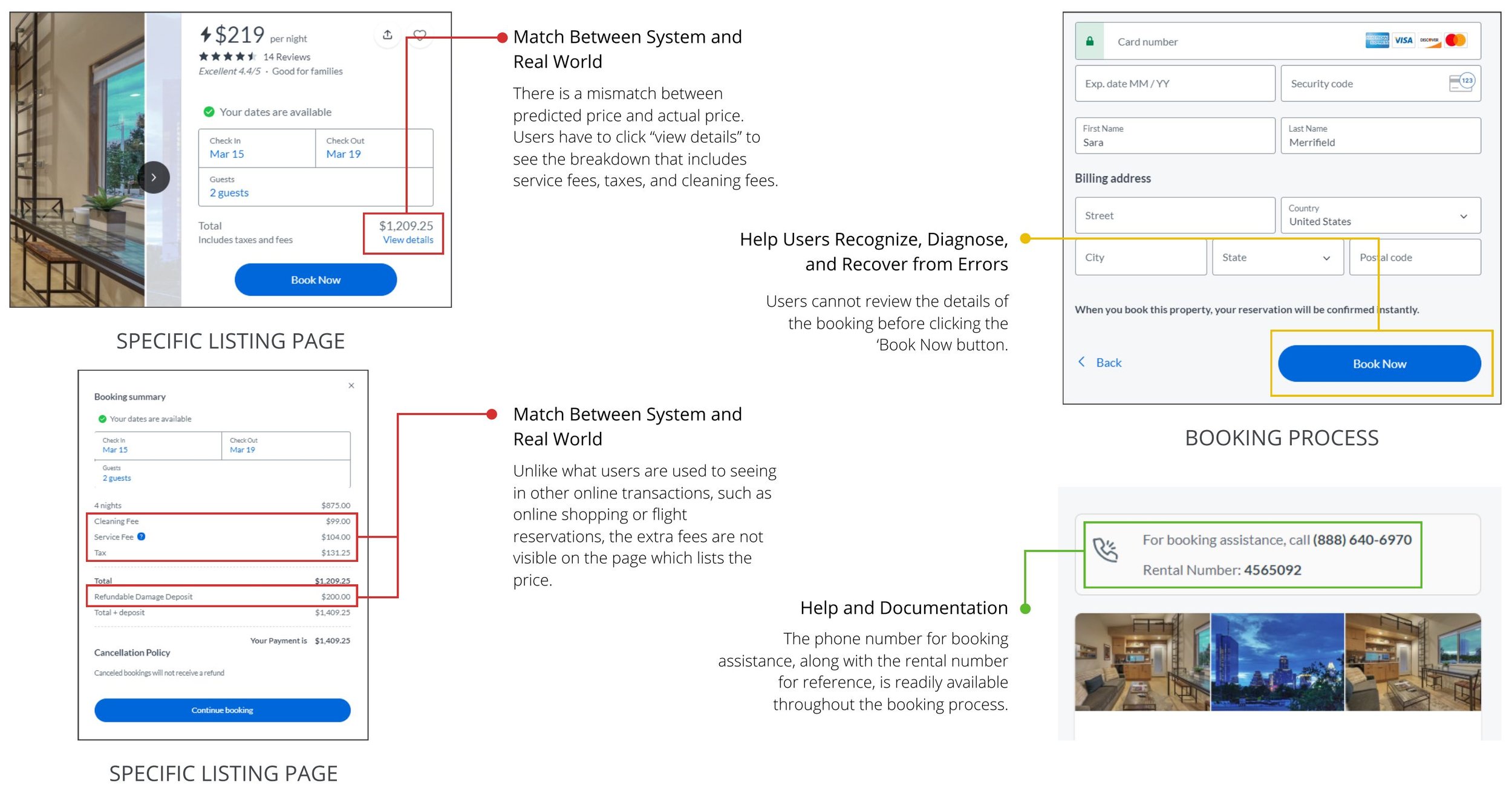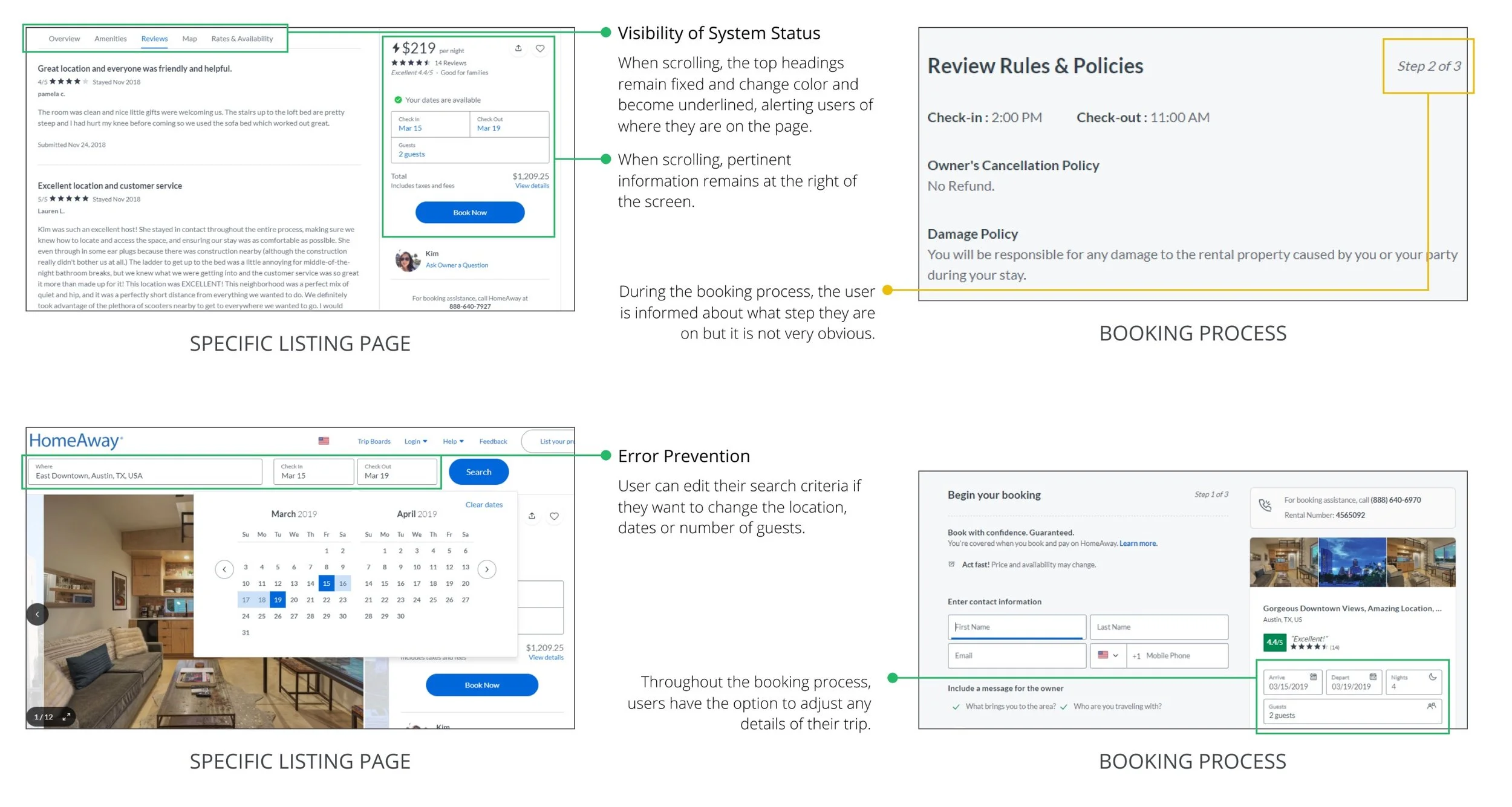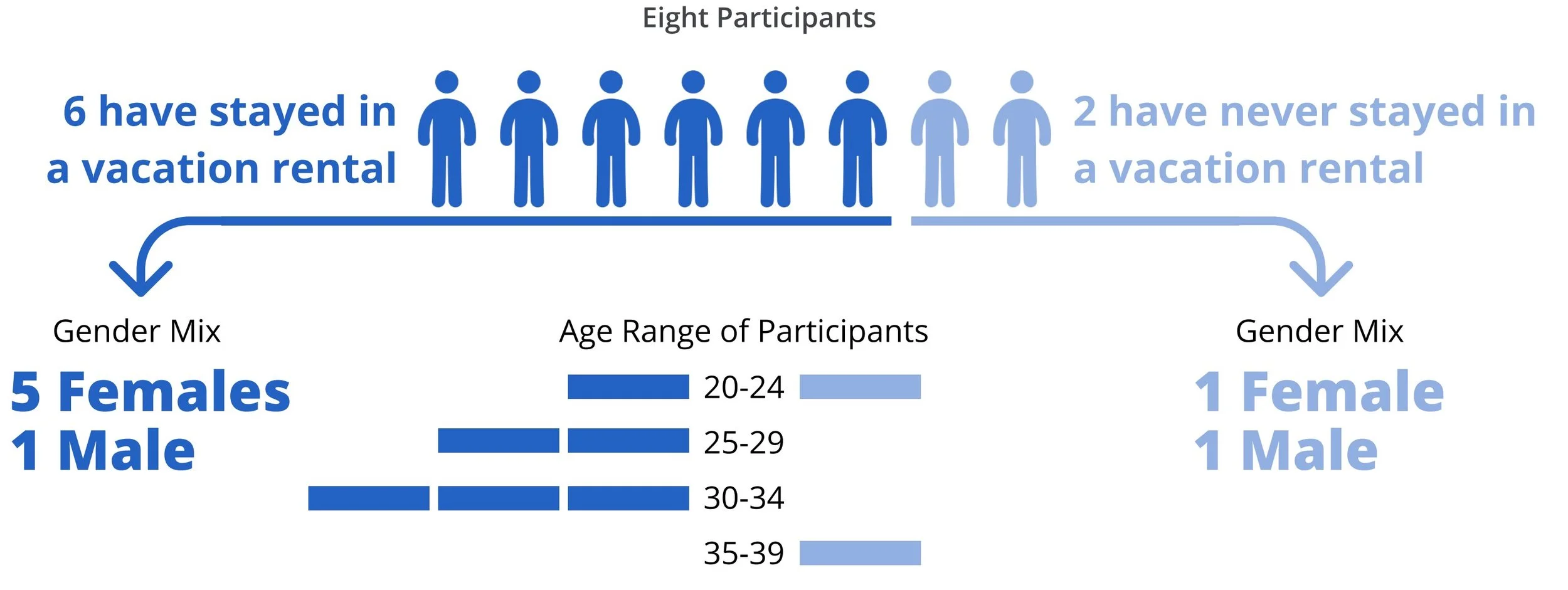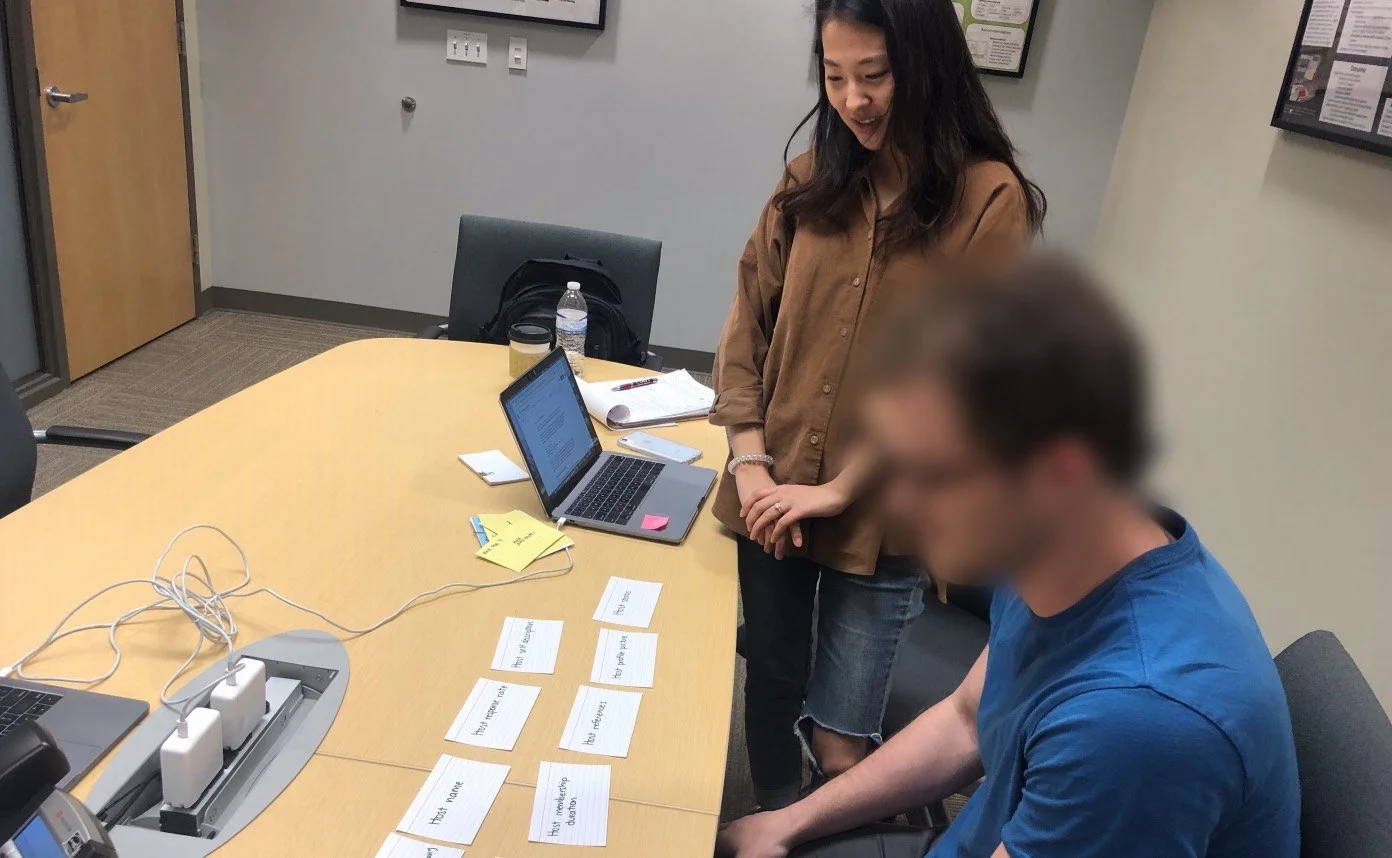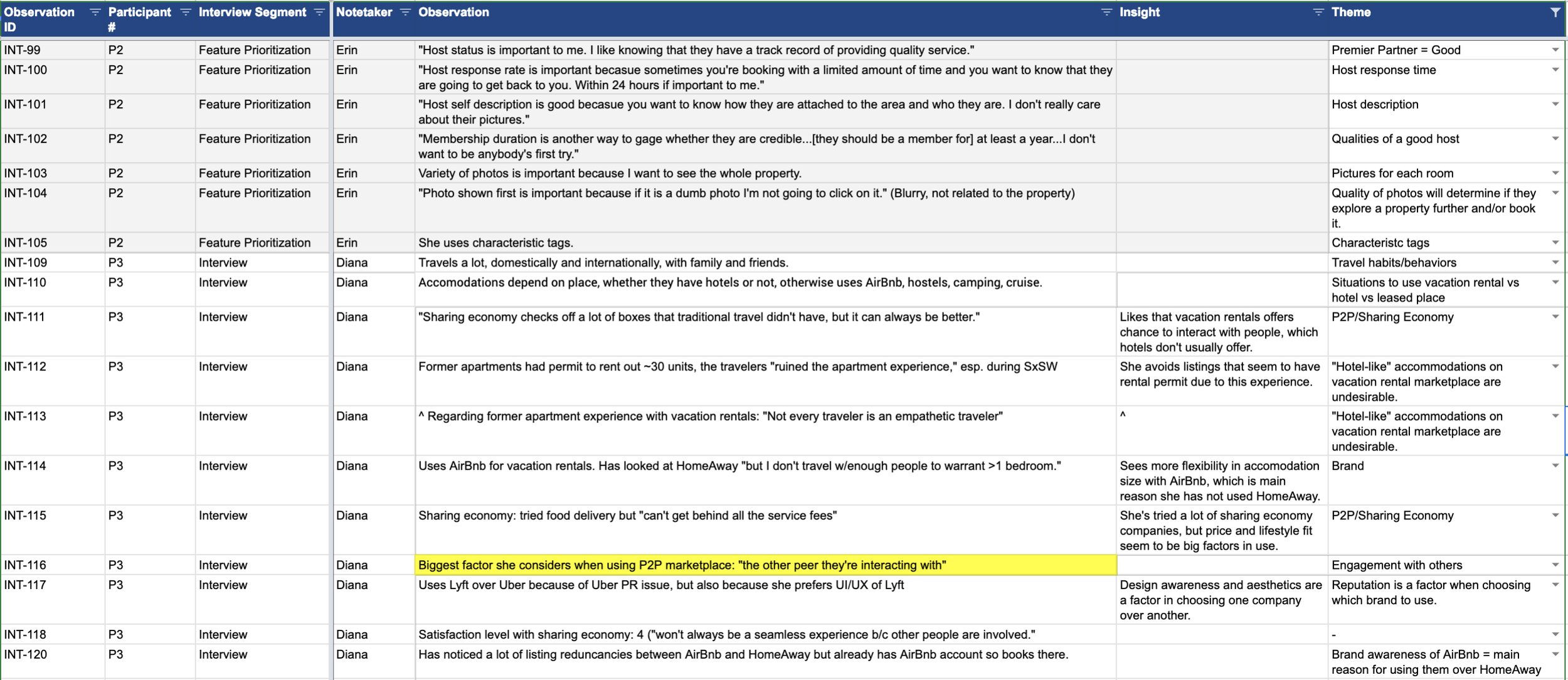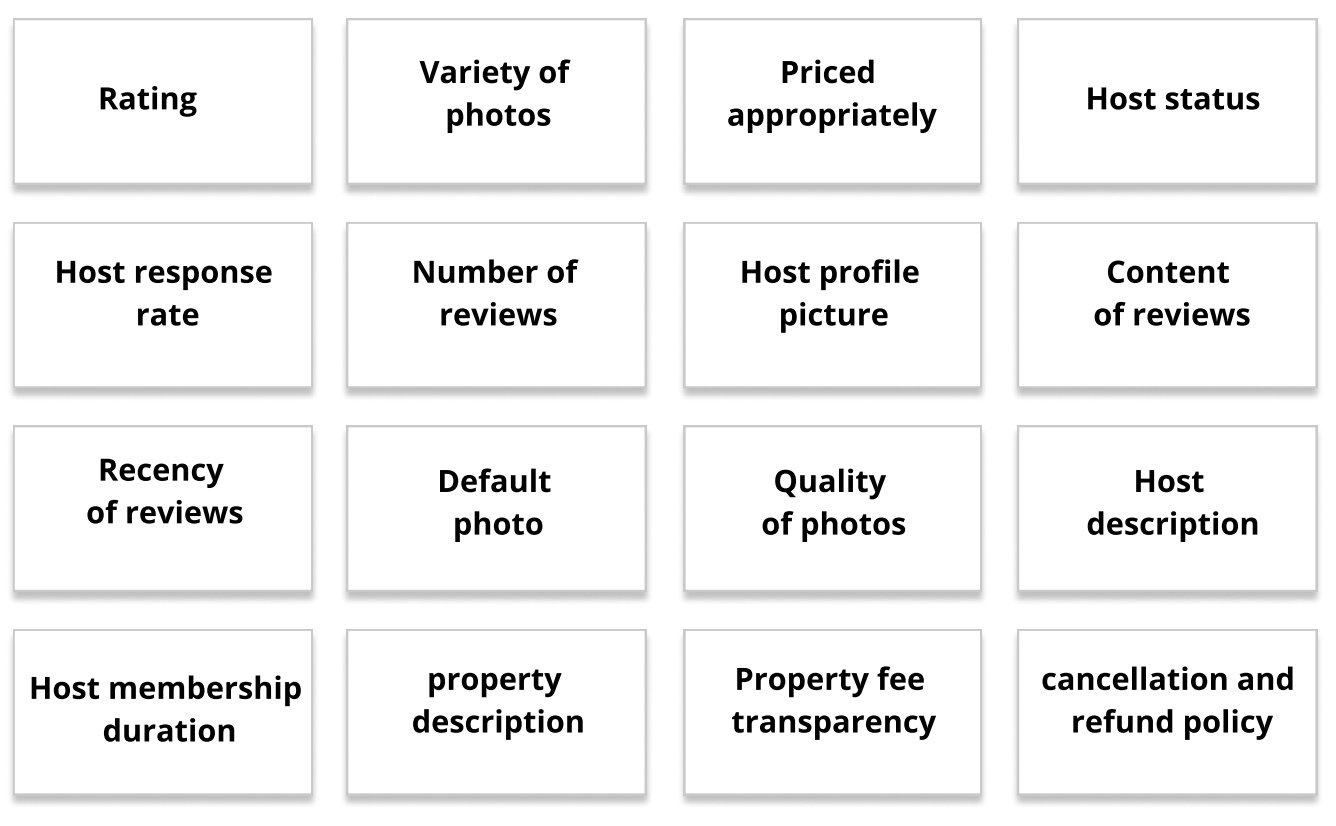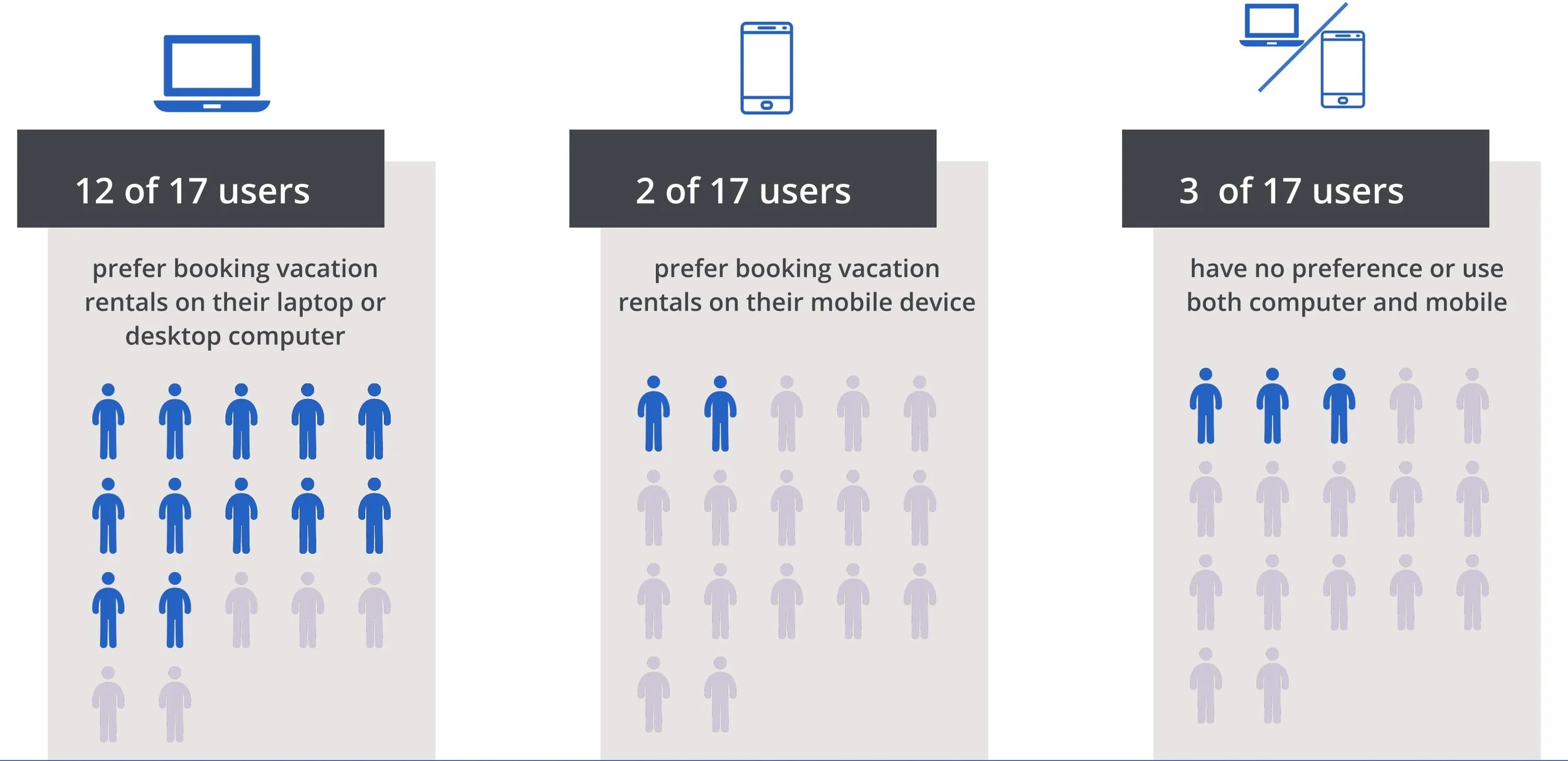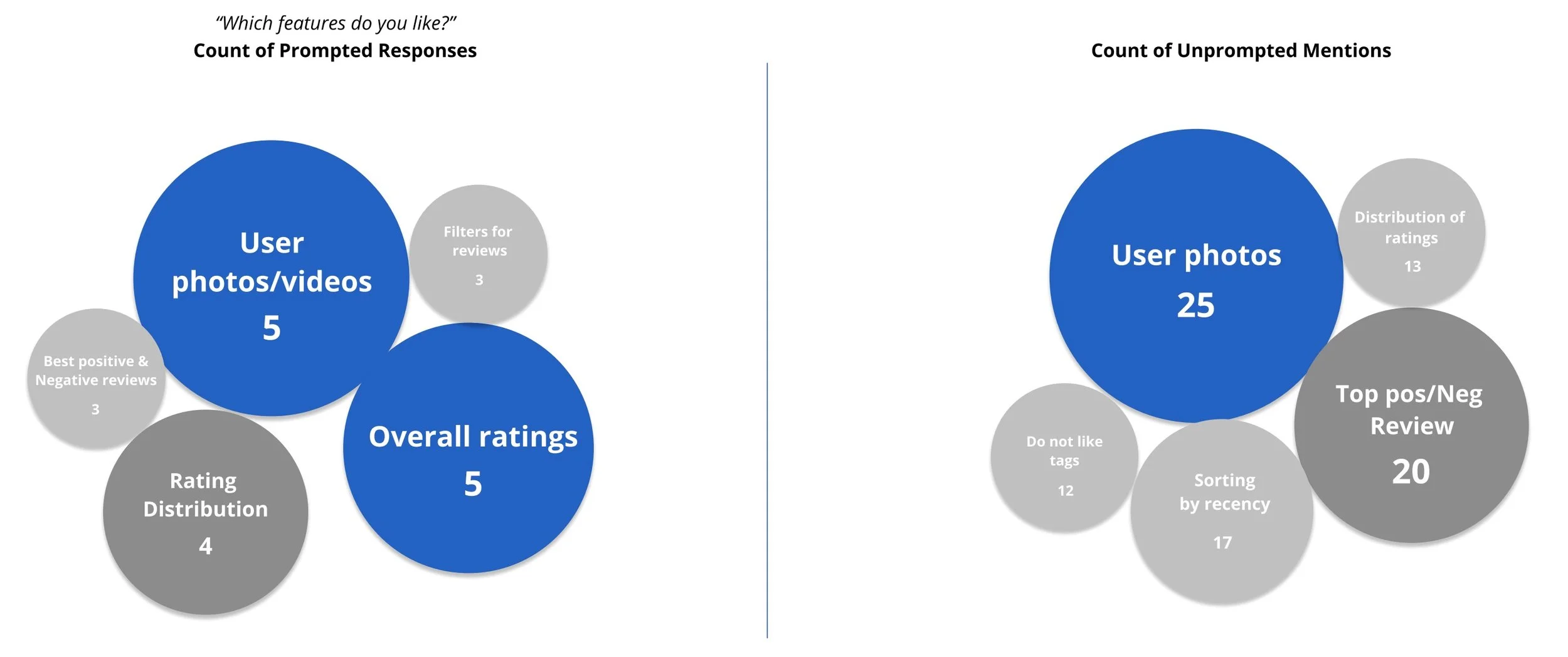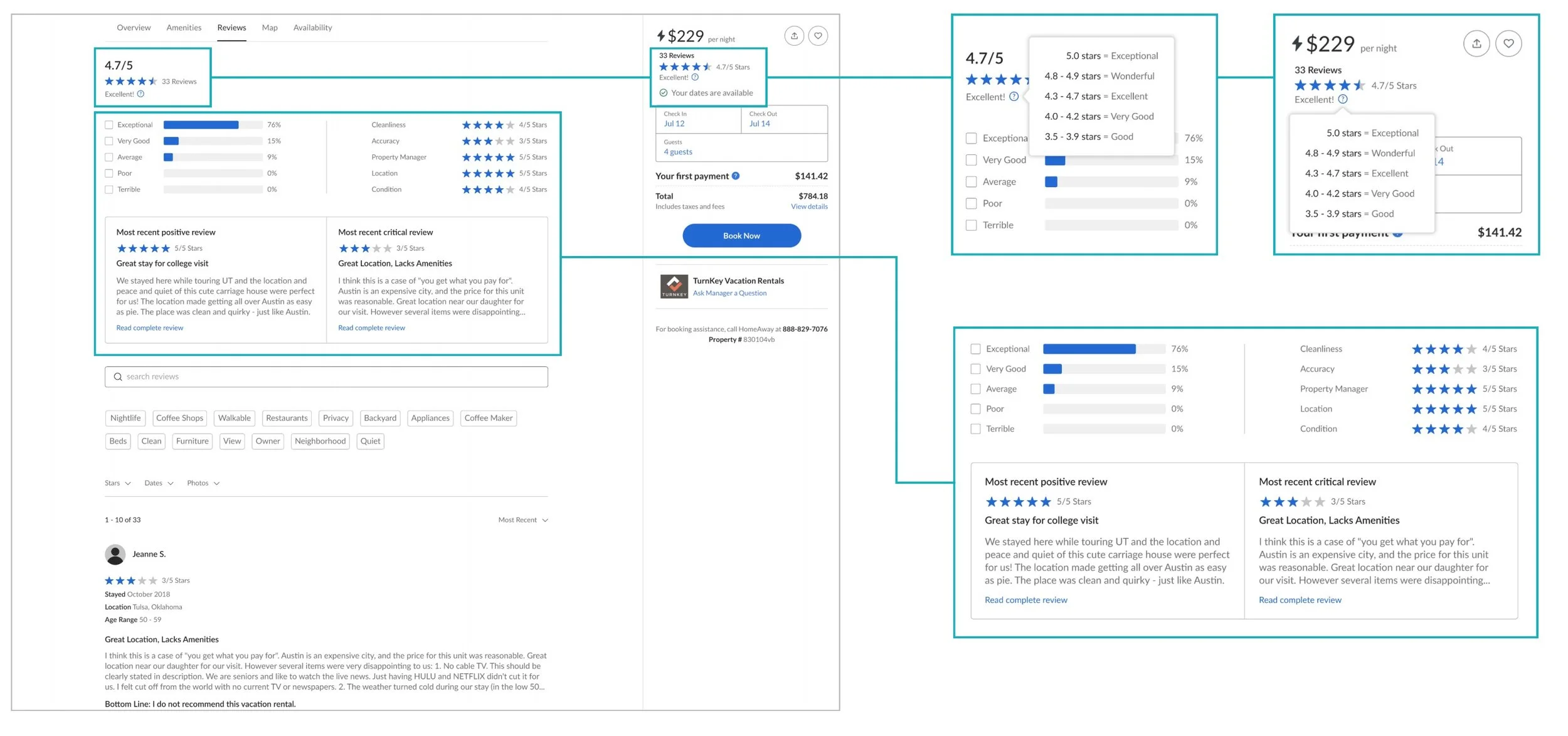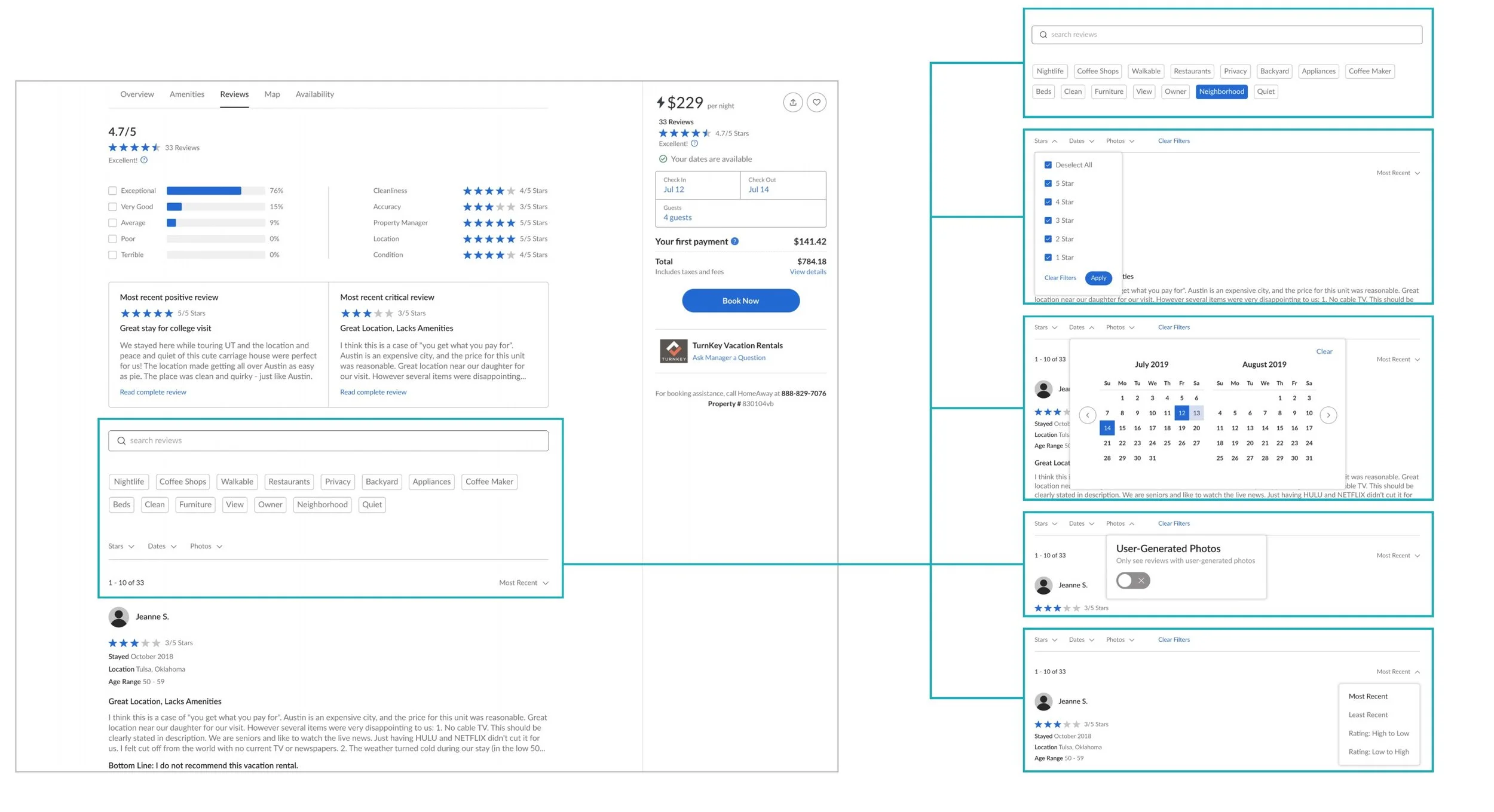
HomeAway (now Vrbo) | Content and Design Elements Affecting Trust
Summary
Team
Diana Mendoza (UX Researcher)
Erin Finley (UX Researcher and Designer)
Sara Merrifield (UX Researcher)
Monica Cho (UX Researcher)
Problem statement
Trust is the currency of the sharing economy. Due to the importance of trust for key metrics at HomeAway such as user engagement and rental bookings, the HomeAway team approached us with the goal of exploring the complex construct of trust in the context of peer-to-peer (P2P) marketplaces.
Solution
To narrow the scope of research to fit within our timeline, we chose to investigate what affects potential HomeAway customers as they evaluate if they are willing to rely on another in the face of risk. To ensure that our findings and final recommendations were actionable and not abstract, our primary research questions for our project became the following:
PRIMARY: What design and content elements influence trust in the context of vacation rental peer-to-peer marketplaces?
SECONDARY: What do consumers consider when browsing and choosing vacation rentals?
SECONDARY: What design and content elements do consumers consider when browsing vacation rental websites?
SECONDARY: How do consumers define trust in the context of vacation rental peer-to-peer marketplaces?
As part of our goal of providing actionable recommendations, we delivered sample mockups to the HomeAway team that were informed by our findings from competitive analyses, heuristic evaluations, generative interviews and survey responses, and summative interviews.
To view a one-sheet summary of our project, click here.
Process and Timeline
Generative Research
Literature review
To better understand the context of the problem, we reviewed 14 articles that explored trust, whether it was trust in the sharing economy, trust in peer-to-peer marketplaces like AirBnb and Uber, or just the general concept of trust. There were three findings in particular from these articles that we felt had strong implications for this project:
"Trust in the platform, trust in the community, trust in the seller, and trust in the buyer are extremely intertwined." From this we found that while we were focused on trust in peers from the consumer perspective, we could not ignore how trust in a brand might also influence trust in peers. (Source: Antecedents of trust in the sharing economy: A systematic review)
"The representation of the product of service being shared is as important as the representation of the people doing the sharing." We felt that this led to a design implication for content and design elements to be sorted into categories (including host information and property information) in order to account for this differentiation. (Source: The sharing economy as a community marketplace? Trust, reciprocity and belonging in peer-to-peer accommodation platforms")
"User reputation is a driving force. The perception users have toward other users depends on multiple factors." This planted the seed that user reputation may be one of the most important elements of trust in P2P marketplaces. (Source: Digital Identity: the effect of trust and reputation information on user judgment in the sharing economy)
Competitive analysis
We evaluated a total of 12 products: 4 direct competitors and 8 indirect. All 12 were P2P marketplaces though not all focused on vacation rentals. While there were no obvious patterns among the products, it did provide us with a sample of design patterns that we later used in our final mockups.
Heuristic Evaluation
As one of our final steps for contextual information gathering, we conducted a heuristic evaluation of HomeAway's current site to have a solid understanding of the current user experience. Doing this in tandem with the competitive evaluation also let us immediately see key differences between HomeAway's interface and other P2P marketplaces. A sample of our evaluation is provided below.
Generative Interviews and Feature Prioritization
Now that we had a good understanding of the general concept of trust and how P2P marketplaces create their user experiences to try to instill trust in their users, it was time to talk to users themselves. We wanted users with a variety of experiences in the sharing economy, so we did not screen out participants that had never stayed in a vacation rental. Out of 19 responses to our interview request, we had 16 qualified participants, 8 of which we interviewed personally.
We created an interview script with six sections: introduction, warm-up, sharing economy, vacation rentals, website exploration, and retrospective. The website exploration portion entailed allowing the participant to browse AirBnb.com, flipkey.com, and homeaway.com and provide us their candid thoughts as they searched for a similar property listing across the three platforms.
We followed this up with a feature prioritization exercise, where we asked them to sort key content elements in order of priority for determining trust. These elements included: host information, property information, booking information, fees, policies, ratings & reviews, and photos of property. We finished up with a retrospective, asking the users to define trust and what it means to them in the context of what we had discussed in the interviews.
After the conclusion of the interviews, we input all of our notes and observations (365 of them total) into a spreadsheet to start coding them and track key quotes. Each note or observation was assigned an observation ID, and the participant number and segment of the interview was also noted.
Data Coding and Affinity Diagram
We then transferred our notes to stickies in order to create an affinity diagram and identify key themes. Given the amount of observations we had recorded, our affinity diagram took up two whole walls in a conference room. Despite the amount of work that went into this exercise, it allowed us to iteratively group the observations into categories and identify key themes and findings.
Key findings from the interviews and feature prioritization exercises were the following:
-
Branding is key in determining whether or not the participants will book with a marketplace. Some participants were repeat customers on AirBnb solely because of past experience with the company and the ease of already having an account, with no hard feelings towards HomeAway.
-
When it comes to P2P vacation rentals, users are expecting unique experiences unlike a hotel stay. They were put off by the presence of property management companies hosting properties on vacation rental sites. For vacation rentals, users are expecting to rent from an individual, not a company.
-
Unsurprisingly, photos of the property listing were marked as very important in determining trust, with users trusting listings with higher quality pictures because they seem to "be trying harder" as well as giving them an ability to fact-check the listing details.
-
Users want transparency when it comes to P2P marketplaces like vacation rentals. They are not put off by hosts who indicate the listing is to make extra cash and actually appreciate their honesty. Payment transparency was also a big factor in liking AirBnb over HomeAway.
-
A rather surprising finding was how much a property title factored into a user's trust in a listing. There was a fine line between a quirky title and "marketing crap." Additionally, users paid extra attention to host statuses to ensure that they have hosted quality experiences in the past.
-
Interview participants also spent a good amount of time scanning a property's reviews, with some of them listing it as their number one item that the review when considering a rental. The importance of reviews was tied to the expectation of having more interaction with the host than one normally would in a regular hotel stay. A couple of female participants noted safety as another reason they combed through reviews, to ensure that past female guests had felt safe during their stay.
Survey
From the feature prioritization exercise we conducted during the interviews, we identified some key elements that were missing that participants expected to see during the exercise. We decided to re-run this same exercise by way of a survey, allowing us to collect more responses than in-person interviews would. The survey was simple and asked: Of the following options, select your top five that you believe influence your trust as you are browsing and choosing a vacation rental. We gave survey participants the following options:
We received a total of 87 valid responses to our survey - 59 females and 28 males. The top five features selected were:
Content of reviews
Rating
Number of reviews
Quality of photos
Variety of photos
Summative research
Summative interviews
The Qualtrics survey uncovered insights that allowed us to determine that there were recurring themes: reviews and ratings were found to be the top two most influential factors that affected trust when booking and staying in vacation rentals. Because these two topics were closely intertwined, we wanted to explore them further so we conducted a brief analysis of how other websites organize and display their ratings and reviews. We chose three sites to compare with HomeAway’s experience that we felt represented a good variety of how websites display this information: Glossier, Amazon, and TripAdvisor.
We recognized HomeAway’s desire to focus on mobile se so we conducted an additional round of interviews using participants’ mobile phones. The findings from these interviews helped us identify specific features surrounding ratings and reviews to help inform our design recommendations to the client.
Final recommendations
During the final phase of the project, we created mockups that include the rating and review features that were deemed crucial for trusting a vacation rental listing and, consequently, the brand. Some of the features that we included as recommendations were:
the ability to sort reviews by recency and by rating, whether that be highest to lowest or vice-versa;
a visual distribution of ratings for at-a-glance comprehension;
having the overall rating be more noticeable;
and most importantly, an ability to add user-generated content such as photos.
We also recommended providing guidelines to users on how to write more effective reviews, such as giving the key takeaways from their experience at the top of their review, giving a descriptive title that sums up their stay, and keeping their review at a reasonable length.
Current state of HomeAway
Recommended design: Key metrics
Recommended design: Search, filter, and sort
Recommended design: Improved visual hierarchy
Recommended design: Mobile experience
